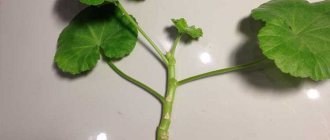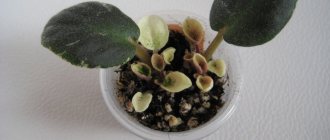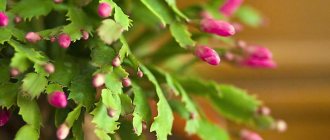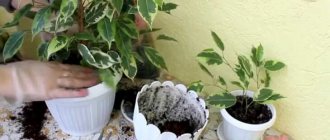Sooner or later, everyone who grows Schlumbergera at home has a desire to propagate this beautiful plant. The most common method of propagation of the Decembrist is vegetative, by cuttings. This method is popular due to its simplicity and high rooting rate.
A cutting is a part of a plant that is used for vegetative propagation. After planting in the substrate, the cutting will develop roots and buds and grow into a new plant. Cuttings for all varieties of Decembrist occur the same way.
When is the best time to take cuttings?
By propagating Schlumbergera using cuttings, you can get a new flower while maintaining all the specific characteristics of the mother plant.
During flowering, the Decembrist should not be disturbed or taken for propagation material. The most suitable time for cuttings is the beginning of spring , when the flowering period of the zygocactus ends and the growing season begins.
If it was not possible to separate the cutting in the spring, it can be taken in the summer, when the bush is forming.
Description of the Decembrist
Belongs to the genus of epiphytic cacti. It occurs naturally in the tropics of Brazil, from where it was brought in the 19th century. The abundant flowering in winter can easily be explained by the fact that in Brazil it is the height of summer when we have winter.
- This succulent is able to accumulate water in its tissues, so it easily tolerates dry periods.
- Decembrist is a cactus, but not a simple one, but without thorns. Instead, he has fine hairs.
- It loves humidity and will stop blooming without good watering.
- In tropical forests it grows like a vine, attached to trees by its roots. It receives nutrition from its leaves and roots. This plant is not a parasite.
- The characteristics are very similar to an orchid, only more unpretentious.
- In indoor conditions, the Decembrist does not grow more than half a meter, branches beautifully and resembles a bush.
- A large number of Schlumbergera varieties have been developed. They differ in leaf shape and flower color. Species plants have flowers of two colors: white and red. In culture, the color of flowers is yellow, various shades of pink, red, orange, and purple. I still can't get blue flowers out.
| Reference. In our country, two types are often found. This is Schlumbergera Bookley and Schlumbergera truncated. |
Photo: Instead of spines, the plant has small hairs.
How to determine that a shoot is ripe?
Choosing a shoot suitable for cuttings is not difficult. It is necessary to carefully examine the Schlumbergera and find long, weakly branched or not branched stems at all. In this case, it is possible to pinch the stem of the zygocactus so that it begins to branch, and to separate the cutting for propagation.
You should choose strong and healthy shoots, with good turgor, without scratches, cracks and other mechanical damage to the leaf plates. It is desirable that they have aerial roots.
Shoots suitable for propagation must have at least 2, and preferably 3, segments. In some cases, it is possible to root even one leaf, but with a less predictable result. It also makes no sense to take shoots with 5 or more segments - long cuttings are inconvenient to work with.
Reference! In order to get a lush bush, several cuttings should be taken at once.
Air humidity
When growing Decembrist at home, care involves ensuring suitable air humidity. The South American origin of zygocactus should be taken into account. The plant requires spraying the leaves with warm water to prevent them from becoming lethargic. In addition to spraying, you can place a tray with wet expanded clay.
In summer it is necessary to spray several times a week, and in winter - 1-2 times throughout the month. For this procedure, use a spray bottle or a watering can with a shower. The water should be at room temperature.
What soil is suitable for planting?
The soil for planting cuttings should be light and loose. You can purchase ready-made soil intended for cacti or universal peat-based soil at a flower shop. also prepare the soil mixture yourself . To do this you need to mix in equal proportions:
- leaf soil;
- turf land;
- peat;
- river sand.
To improve its structure, add perlite and crushed sphagnum moss to the resulting soil mixture.
The main requirement for the soil is that its acidity should not exceed pH 5.0-6.5.
Typical mistakes during transplantation
Unfortunately, novice flower growers, having not received enough information about this exotic plant, make a lot of mistakes when transplanting it, which often prove fatal for the Decembrist. To avoid this, you need to have reliable knowledge of how to properly maintain and care for a Christmas tree so that it always pleases the eye with lush flowering and an attractive shape.
Let's look at the most common mistakes made when replanting a plant:
- The most common mistake is an incorrectly selected container for containing Decembrist - it should not be too spacious, since plants of this type with a poorly developed root system do not need this. If you neglect this rule and transplant the zygocactus into a spacious pot, its development and, accordingly, flowering will stop, since it will direct all its forces to the development of roots.
- An equally common mistake is replanting Decembrist during the flowering period. If replanting in summer and autumn does not lead to anything fatal, then at the budding stage the plant should never be exposed to stress, otherwise there is a risk of its death.
- One of the biggest misconceptions is also the version that the flower needs to be periodically turned around its axis, but this is not the case. It is strictly forbidden to change the phytodirection of the plant, otherwise all the buds will immediately fall off. This will also happen if the Decembrist produces an excessive number of flowers that the plant cannot cope with. Then some of the buds will have to be eliminated to ensure the normal development of the Christmas tree.
- Under no circumstances should the plant be placed in direct sunlight , but diffused light contributes to its more productive development. For this reason, in the summer, it is recommended to hang a special scattering fabric on the window where the Decembrist grows.
- Another rule that beginners often forget about is the complete lack of watering in the first few days after transplanting. Since the plant requires complete rest during this period, such active procedures will have negative consequences for it, so careful care should be abandoned at first and the flower should be touched only as needed.
Such an exotic plant as the Decembrist, although it seems at first glance rather capricious and demanding, actually requires very simple care and, with the proper approach, will certainly please the owners with its excellent appearance and beautiful flowers.
And a correctly carried out transplant will help achieve such results and provide the zygocactus with a good incentive for growth and flowering.
- Author: Maria Sukhorukikh
Rate this article:
- 5
- 4
- 3
- 2
- 1
(0 votes, average: 0 out of 5)
Share with your friends!
Which container is best to choose for rooting?
Zygocactus has a small and weak root system, especially if we are talking about a very young plant. In addition, after thorough rooting of the cuttings, they need to be transplanted into soil with a more nutritious composition, so rooting does not require a large container . You can use plastic cups or small flowerpots with a volume of approximately 150-200 ml.
There must be drainage holes at the bottom of the container used, and immediately before planting the cuttings, it is necessary to pour a drainage layer into it at least 1/3 of the height, which can be expanded clay, perlite, vermiculite, broken brick or small pebbles.
Useful video
From the video you will learn how to transplant a rooted Schlumbergera cutting:
If you find an error, please select a piece of text and press Ctrl+Enter.
Decembrist cannot be called an overly demanding plant. However, you should not neglect the rules of caring for it. This also applies to transplantation.
An untimely or incorrectly performed procedure harms Schlumbergera and prevents flowering.
Therefore, it is important not only to know how to transplant Decembrist, but also to choose the most favorable moment for these manipulations. Is it possible to transplant a flowering plant in winter or is it better to choose another time? How to act correctly? We will tell you step by step about the transplant procedure and show you a photo.
Step-by-step instructions on how to root Schlumbergera
To separate the selected cutting, you need to pinch it with your fingers and, turning clockwise, carefully unscrew it from the mother plant, holding the branch with your other hand.
Under no circumstances should you use scissors, a scalpel, a knife or any other sharp objects, otherwise the planting material may be damaged.
The separated cutting must be dried for 48 hours by placing it on a napkin and putting it in a dark place, after which a thin film will appear on the detached area.
For rooting there are 2 equal options: in soil and in water.
In water
It is necessary to place the cutting in water at room temperature so that it covers 1 of its segments. If the water level drops, it should be added. It is important to monitor the condition of the water: if it becomes cloudy, it must be replaced immediately and the cuttings must be washed to avoid the possibility of rotting.
The roots appear after 7-14 days ; you can speed up this process by adding a few “Kornevin” to the water.
When the roots reach a length of more than 2 cm, the cuttings need to be transplanted into the ground.
Important! The water used must stand for at least 24 hours so that chlorine and its derivatives are removed from it, otherwise the young zygocactus may die.
In the ground
You need to thoroughly wash and disinfect the container for planting the cuttings, add a drainage layer and prepared soil to the bottom. Next, you should water the soil and vertically deepen the cutting into it by about 5 mm.
If a large pot is chosen as a container for planting, 2-4 cuttings should be planted in it, if a plastic cup - 1.
It will take about a month for the zygocactus to take root in the soil . To speed up the growth of roots, “Kornevin” is used - you should dip a cut of the shoot into it before planting.
Preparing for transplant
Preparing a zygocactus for transplantation includes several stages: choosing a container, cultivating the soil and the plant itself. It is important to take care of all this in advance to ensure the most comfortable conditions for the flower. To do this, you need to first familiarize yourself with its requirements for the pot and soil. Let's look at each point in more detail.
Choosing a pot
The container in which the Christmas tree will grow is an important component of its growth and development. For the Decembrist, the ideal container would be a not very high and deep pot, since the root system of the flower is located superficially and does not reach the bottom. At the same time, a pot that is too spacious will provoke an intensive growth of roots and green mass of the zygocactus, which will interfere with the formation and development of buds and will result in a lack of flowering.
If you transplant the plant into a container that is too deep, this will lead to stagnation of water at the bottom and subsequently to waterlogging of the soil. The best option is to choose a flowerpot that is only 2–3 cm larger than the previous one, and the material from which it is made does not play a special role. The most important thing is that there is at least 1 drainage hole at the bottom of the pot.
Soil preparation
- Zygocactus also has its own preferences regarding soil:
- the soil must be loose and well permeable to water;
- the soil should be slightly acidic - the acidity level pH should not exceed 6.0;
- the soil must be saturated with organic matter.
In agricultural stores today there is a huge selection of ready-made soil mixtures. The most optimal option would be the one labeled “For cacti.” It is recommended to have various large inclusions in the soil - these could be brick chips, sand or pieces of coal. As a rule, the most suitable nutrient mixture for the Decembrist is turf soil.
To disinfect the soil, crushed coal must be added to it, and expanded clay must be added to increase impermeability. However, you can also make the soil yourself by selecting the necessary ingredients.
The ideal composition for Christmas is as follows:
- turf soil - 5 parts;
- humus - 3 parts;
- leaf soil - 2 parts;
- peat - 2 parts;
- crushed coal - 20%;
- brick chips - 20%.
Before planting a plant in a pot, it is necessary to create a layer of expanded clay drainage at its bottom, occupying 1/4 of the height of the container. Subsequently, this will facilitate further care of the Decembrist and protect its roots from rotting.
Flower processing
Before transplanting the Christmas tree to a new place, you should take care of its appearance - put the bush in order, thoroughly wash and wipe it. First you need to trim the plant to give the bush a more attractive shape. However, it is important not to cut off excess sections on the shoots, but to unscrew them manually. This will allow you to form a more lush and profusely flowering bush with healthy large flowers.
Difficulties and problems of cuttings
When taking cuttings you may encounter some problems:
- the leaf segments turn red - this is probably due to direct sunlight on the young plant;
- the cuttings wither - this occurs due to violation of the rules for caring for the plant (watering and spraying with cold water, excess fertilizing) or the development of a fungal infection;
- the cutting is rotting - most likely the problem is an excessive amount of moisture; it is necessary to remove the cutting from the soil, remove the damaged parts, dry it for 48 hours and plant it in new soil, reducing watering.
Stimulating growth
The flower needs peace. With the onset of autumn, it should be moved to a cool place, watering should be limited and fertilizing should be stopped. Under these conditions, the plant lasts until the end of November, and then the usual care regime must be returned. The pot should be placed in a warm place, placed in a well-lit place, and watering should be increased.
After a week, the flower will begin to form buds. You should follow 5 rules that will ensure abundant and long flowering:
- Additional lighting required. In winter, the plant should be placed under fluorescent lamps. Special phytolamps are also suitable.
- During flowering, the plant should not be disturbed. There is no need to rearrange it or move it. Cuttings are also postponed to another time. According to reviews, all actions during flowering cause partial or complete shedding of buds.
- Need coolness. In such rooms, flowering lasts longer. The best temperature is 16 degrees. But you should not allow sudden changes in temperature, as the buds may fall off.
- A small, narrow pot is required.
- For Decembrist flowering, phosphorus-potassium fertilizers are chosen immediately after dormancy. These components have a beneficial effect on the formation of buds.
If you purchased a blooming Decembrist, you should prepare for some of the buds to fall off. The plant gets used to new conditions. It must be placed for 2 weeks separately from other flowers. This is a preventive measure - the initial signs of disease or the presence of pests may not have been noticeable when purchasing. Subject to these rules, long flowering is ensured. The plant will delight with its beauty throughout the winter.
Caring for a young plant
- To maintain a stable microclimate and a high level of humidity after planting the cuttings in the soil, you need to create a greenhouse effect by covering the cuttings with a jar or bag.
- The cuttings must be placed under diffused lighting at a temperature of about +15-20 degrees. The greenhouse needs to be ventilated daily for 30-40 minutes to remove any condensation that appears.
- The soil should not be watered abundantly; it should be moderately moist; watering can only be done after the top layer of soil has completely dried, otherwise the cuttings will rot. It is better to replace watering by spraying with warm, soft water.
Attention! Until the zygocactus is completely rooted, containers with cuttings cannot be moved.
- When new segments appear on the shoots, they need to be transplanted into a flowerpot made of a small plastic glass. Replanting should be done using the transshipment method, leaving an earthen lump around the weak roots.
Decembrist has a shallow root system that does not require deep planting, so the flowerpot should be low and wide, always with drainage holes .
If the rooting of the zygocactus took place in a flowerpot, the flower should not be disturbed for several months, until the roots appear in the drainage holes, speaking of filling the soil.
After transplantation, Schlumbergera needs to be placed in the shade for 10-14 days so that the flower recovers from stress. During the adaptation period, watering should be replaced by spraying. After this, it is advisable to place the rooted cuttings in partial shade on a balcony or veranda. Fertilizers can be applied only after 2-3 months.
Watering
How to care for the Decembrist at home? Regular watering of the plant is necessary. Dry soil has a negative effect on the flower. But you shouldn’t overfill it either, as this can cause Decembrist disease. Water when the soil surface dries out.
It is advisable to carry out this procedure according to the following schedule:
- Between October and November, the flower is installed in a cool place. Watering should be done once a week. In the 2nd decade of November, the plant is watered every other day and sprayed.
- Budding lasts from November to December. Requires abundant and regular watering when dry.
- In December - February, regular watering is needed. The pot should not be moved to another place.
- From March to August it is necessary to water evenly using softened water.
Not all housewives know how and what is the best way to water a plant. Do not use running tap water. It contains a lot of chlorine or limescale deposits. The best drink for the Decembrist is rainwater. It is allowed to use settled boiled tap water.
Suitable soil
The easiest way is to purchase a ready-made soil mixture in the store intended for indoor succulents or cacti. In addition to it, you will need river sand and material to form a drainage layer, most often expanded clay. The first layer in the pot is laid out with drainage, followed by moistened soil and, finally, wet sand. Some growers add perlite to the existing ingredients.
Speaking of soil, one cannot fail to mention the correctly selected container. It is more convenient to take a capacious and flat container that will accommodate all the sprouts. There is no need to choose containers that are too voluminous, as in this case the succulents will begin to devote all their energy to the formation of roots, and not to the growth of green mass. In this case, the development of the plant will slow down. The preferred materials for the pot are clay and plastic.











